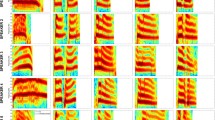Abstract
It is known that the accuracy of perceptual speaker identification is dependent on the stimulus contents presented to the subjects. Two experiments were conducted in order to find out the effective sounds and to investigate the effects of the syllable structures on familiar speaker identification. The results showed that the nasal sounds were effective for identifying the speakers both in onset and coda positions, and coronal sounds were more effective than labial counterparts. The onset consonants were found to be important, and the identification accuracy was degraded in onsetless structures.
This work was originally presented at the 9th European Conference on Speech Communication and Technology Interspeech 2005 (Experiment 1) and at the International Workshop on Frontiers in Speech and Hearing Research 2006 (Experiment 2). For details see references [23] and [24].
Preview
Unable to display preview. Download preview PDF.
Similar content being viewed by others
References
Abercrombie, D.: Elements of General Phonetics. Edinburgh Univ. Press, Edinburgh (1967)
Laver, J.: The Phonetic Description of Voice Quality. Cambridge Univ. Press, Cambridge (1980)
Ball, M., Rahilly, J.: Phonetics. Arnold, London (1999)
Hollien, H.: The Acoustics of Crime. Plenum, New York (1990)
Furui, S.: Acoustic and Speech Engineering. Kindai Kagaku-sha Publishing Company, Tokyo (1992)
Hashimoto, M., Kitagawa, S., Higuchi, N.: Quantitative Analysis of Acoustic Features Affecting Speaker Identification. J. Acoust. Soc. Jpn. 54(3), 169–178 (1998)
Kuwabara, H., Sagisaka, Y.: Acoustic Characteristics of Speaker Individuality: Control and Conversion. Speech Com. 16, 165–173 (1995)
O’Shaughnessy, D.: Speech Communications –Human and Machine, 2nd edn. Addison-Wesley Publishing Company, New York (2000)
Nygaard, L.: Perceptual Integration of Linguistic and Nonlinguistic Properties of Speech. In: Pisoni, D., Remez, R. (eds.) The Handbook of Speech Perception, pp. 390–413. Blackwell Publishing, Oxford (2005)
Kreiman, J., van Lacker, D., Gerratt, B.: Perception of Voice Quality. In: Pisoni, D., Remez, R. (eds.) The Handbook of Speech Perception, pp. 338–362. Blackwell Publishing, Oxford (2005)
Goggin, J., Thompson, C., Strube, G., Simental, L.: The Role of Language Familiarity in Voice Identification. Memory and Cognition 19, 448–458 (1991)
Bricker, P., Pruzansky, S.: Speaker Recognition. In: Lass, N. (ed.) Experimental Phonetics, pp. 295–326. Academic Press, London (1976)
Amino, K.: The Characteristics of the Japanese Phonemes in Speaker Identification. Proc. Sophia Univ. Ling. Soc. 18, 32–43 (2003)
Amino, K.: Properties of the Japanese Phonemes in Aural Speaker Identification. Tech. Rep. IEICE 104(149), 49–54 (2004)
Bricker, P., Pruzansky, S.: Effects of Stimulus Content and Duration on Talker Identification. J. Acoust. Soc. Am. 40(6), 1441–1449 (1966)
Kitamura, T., Akagi, M.: Speaker Individualities in Speech Spectral Envelopes. J. Acoust. Soc. Jpn (E) 16(5), 283–289 (1995)
Matsui, T., Pollack, I., Furui, S.: Perception of Voice Individuality Using Syllables in Continuous Speech. In: Proc. Autumn Meet. Acoust. Soc. Jpn, pp. 379–380 (1993)
Nishio, T.: Can We Recognise People by Their Voices? Gengo-Seikatsu 158, 36–42 (1964)
Stevens, K., Williams, C., Carbonell, J., Woods, B.: Speaker Authentication and Identification: A Comparison of Spectrographic and Auditory Presentations of Speech Material. J. Acoust. Soc. Am. 44(6), 1596–1607 (1968)
Nakagawa, S., Sakai, T.: Feature Analyses of Japanese Phonetic Spectra and Consideration on Speech Recognition and Speaker Identification. J. Acoust. Soc. Jpn. 35(3), 111–117 (1979)
Ramishvili, G.: Automatic Voice Recognition. Engineering Cybernetics 5, 84–90 (1966)
Sambur, M.: Selection of Acoustic Features for Speaker Identification. Proc. IEEE Trans. ASSP 23(2), 176–182 (1975)
Amino, K., Sugawara, T., Arai, T.: Correspondences between the Perception of the Speaker Individualities Contained in Speech Sounds and Their Acoustic Properties. In: Proc. Interspeech, pp. 2025–2028 (2005)
Amino, K., Sugawara, T., Arai, T.: Effects of the Syllable Structure on Perceptual Speaker Identification. IEICE Tech. Rep. 105(685), 109–114 (2006)
Kindaichi, H., Akinaga, K. (eds.): Meikai Japanese Accent Dictionary, 2nd edn. Sanseido, Tokyo (1981)
Repp, B., Healy, A., Crowder, R.: Categories and Context in the Perception of Isolated Steady-State Vowels. J. of Exp. Psychol.: Human Perc. Perf. 5(1), 129–145 (1979)
Boersma, P., Weenik, D.: Praat Doing Phonetics by Computer. Ver.4.3.14 (Computer Program) (2005), retrieved from http://www.praat.org/
Dang, J., Honda, K.: Acoustic Characteristics of the Human Paranasal Sinuses Derived from Transmission Characteristic Measurement and Morphological Observation. J. Acoust. Soc. Am. 100(5), 3374–3383 (1996)
Hashi, M., Sugawara, A., Miura, T., Daimon, S., Takakura, Y., Hayashi, R.: Articulatory Variability of Japanese Moraic-Nasal. In: Proc. Autumn Meet. Acoust. Soc. Jpn, pp. 411–412 (2005)
Spencer, A.: Phonology. Blackwell, Oxford (1996)
Whaley, L.: Introduction to Typology. Sage Publications, London (1997)
Author information
Authors and Affiliations
Editor information
Rights and permissions
Copyright information
© 2007 Springer-Verlag Berlin Heidelberg
About this chapter
Cite this chapter
Amino, K., Arai, T., Sugawara, T. (2007). Effects of the Phonological Contents on Perceptual Speaker Identification. In: Müller, C. (eds) Speaker Classification II. Lecture Notes in Computer Science(), vol 4441. Springer, Berlin, Heidelberg. https://doi.org/10.1007/978-3-540-74122-0_8
Download citation
DOI: https://doi.org/10.1007/978-3-540-74122-0_8
Publisher Name: Springer, Berlin, Heidelberg
Print ISBN: 978-3-540-74121-3
Online ISBN: 978-3-540-74122-0
eBook Packages: Computer ScienceComputer Science (R0)




